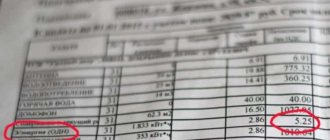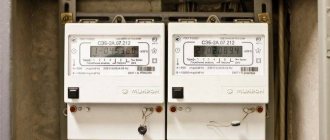A new line has appeared in payments for electricity. This is a collection from residents for general house needs. The calculation of this until the beginning of 2022 was confusing and contradictory. Some citizens received amounts increased by 30%. And this caused bewilderment and misunderstanding on their part. Currently, the methodology is unified. All regions are required to establish and publish increasing coefficients for different types of apartment buildings (MCD).
Let’s look at where the numbers for paying for common household needs (CHO) come from. What can a citizen do to reduce costs? Can electricity suppliers inflate charges?
Normative base
Work on calculating payments for one-way taxation is carried out in accordance with the implementation of the norms of the following acts:
- Housing Code of the Russian Federation (clause 9.1 of article 156);
- Decree of the Government of the Russian Federation No. 354 of 05/06/11.
In the documents, the responsibility for paying for consumed resources rests with the owner. Residents (owners) of apartments are recognized as the collective owner of non-residential premises and adjacent areas. Thus, the law clearly indicates who is obliged to pay money for light.
Download for viewing and printing:
Article 156. Amount of payment for residential premises of the Housing Complex of the Russian Federation
Decree of the Government of the Russian Federation of May 6, 2011 N 354 On the provision of utility services to owners and users of premises in apartment buildings and residential buildings
Appendix 2 to the Decree of the Government of the Russian Federation No. 354
What to do if there is no communal meter
Not every house is equipped with a common building meter, which does not exempt residents from paying ODN. It’s just that the calculation in this case will take place differently – according to state standards with increasing coefficients. As a rule, they are overpriced, and therefore you will have to pay more. It is clear that this is not on a scale to be indignant and indignant, but it is worth taking into account. If it is possible to install a meter on a house, then it is better to do this through the financial efforts of all residents - it will be profitable over a long distance.
There are no uniform standard indicators for Russia. Each region will have its own figure, as well as the electricity tariff. So if your house still doesn’t have a public meter, find out from the management company how much and at what tariff you need to pay specifically in your city. An alternative option is to look up the same information on the Internet. Today it is available in every region of our country.
How is the calculation made for each consumer?
There are two different ways to calculate the payment per consumer. They differ in the accuracy of the final amount. The choice depends on the availability of a general meter for electricity consumption in the apartment building.
If there is a communal meter
If there are readings from two sources, calculations are carried out according to the following logic:
- The total light consumption of all apartments per month is calculated.
- The total consumption of residents is subtracted from the readings of the common house meter.
- The resulting amount is divided among all apartments taking into account their total area.
Thus, each person receives a payment slip with accurate data on electricity consumption for the previous month. Some injustice of this method is that when distributing expenses, the area of the apartment is taken into account, and not the number of registered people. However, this method is more acceptable to users due to its accuracy.
Hint: the difficulty of using general house readings is the need to collect readings from apartment meters. Without them, it is not possible to calculate the readings.
You need to know that utility services do not focus on exact figures for resource consumption, but on internal consumption formulas. Based on data for the last twelve months, they determine the average consumption. Based on its value, the payment for the previous period is calculated.
If there is no common appliance in the house
The lack of accurate accounting of resource consumption led, until the beginning of 2017, to an increase in electricity charges for ODN to a level of 30%. This does not correspond to real indicators of resource consumption. Therefore, the Government of the Russian Federation made the following change to the methodology:
- the authorities of the constituent entities of the federation are obliged to establish increasing coefficients for buildings of various types;
- these should be brought to the attention of: utility services that charge amounts for consumed resources;
- population.
Thus, the authorities took the path of unifying charges. The use of a multiplying factor does not reflect actual electricity costs. However, the rule allows utilities to limit the amount they charge for general consumption.
Calculation formula
To determine the payment amount for each apartment, it is necessary to establish the relative area of usable space used. This is done according to the formula given in the government decree. She is like this:
Rozh = Norm x Poo x (Pkv / Pob), where:
- Norm - coefficient established by the regional government for a given type of building; Poo - common area;
- Pkv - apartment size;
- Pb - the area of the entire building.
The formula is contained in Appendix 2 to the Decree of the Government of the Russian Federation No. 354 (subject to change).
We invite you to familiarize yourself with the information material on the issue of consumption and payment for electricity used for general household needs.
What is general household consumption?
General house needs (hereinafter referred to as GDN) are electricity consumed for lighting entrances, basements, attics, operating fire-fighting automatics, access lamps, antenna amplifiers, intercoms, pumps pumping water to the upper floors of the house, and other electrical equipment necessary to create comfortable living conditions in house and is the common property of all residents. In addition, technological losses in intra-household networks are also paid for as general household consumption.
What are power losses?
Electricity is a resource that does not require additional resources to move it over a distance—it consumes part of itself. When transmitting electricity through an electrical network, technological energy consumption is inevitable in its elements, due to the active resistance of the circuit.
Losses in networks arise due to theft of electricity, due to deterioration of electrical wiring, as well as errors in taking readings of individual meters or deliberate distortions of records.
In old housing stock, where intra-house electrical networks are characterized by a high level of wear and tear, the electrical wiring has not been replaced, and the level of electricity losses is usually quite high. Therefore, it is primarily the residents of the building who are interested in upgrading power lines in order to adapt them to modern network load levels.
Why should I pay for household consumption?
The owner of an apartment in an apartment building, along with the apartment, also owns a share of the common property of the house, which is proportional to the size of the total area of the apartment.
Therefore, the owner (tenant) of an apartment is obliged to pay not only for individual electricity consumption, but also for electricity consumption for general house needs.
Where is the general house meter installed and who takes readings from it?
Common house metering devices (CDMU), as a rule, are installed at the border of electrical networks included in a residential building. If there are several such inputs into a house, then they are all equipped with separate common house metering devices, the volume of supply for which is summed up in further calculations. You can find out about the specific location of a common house appliance from the management company.
ODPU readings are taken monthly by employees of the network organization or management company.
How is the volume of ODN in an apartment building determined?
If there is a common house (collective) metering device, from the electricity consumption according to the collective (common house) metering device installed at the entrance to the house, the electricity consumption according to individual (apartment) meters and the amount of electricity consumed by citizens who do not have meters, determined according to the standards, are subtracted. If there are non-residential premises in a multi-apartment residential building (shops, pharmacies, etc.), their consumption volume is also deducted from the consumption of a common building meter.
Step 1 - readings of the common house meter are taken on the last day of the month. Let’s say the volume of electricity determined by a common house meter was 36,120 kWh.
Step 2 - the readings of all apartment meters in the house are taken and summed up, the volume according to the standard in apartments where metering devices are not installed, as well as the consumption volumes of legal entities, which are counted from the input meter. Let's assume this volume is 24,573 kWh.
Step 3 - the expenses for the needs of the house are established. This is the difference between the volume of electricity according to the general house meter and the volume of consumption of all residential and non-residential premises (36,120 kWh - 24,573 kWh = 11,547 kWh).
Step 4 - the difference (11,547 kWh) is divided by the area of all living spaces in the house. Let's say the area is 9,822.39 m2. The result of the calculations is 1.175 kWh/m2.
Step 5 - multiply the resulting figure by the area of a specific apartment (for example, 37 m2) and the current tariff (3.14 rubles in houses with gas stoves). Result: owners of an apartment with an area of 37 m2 will pay for electricity consumption for the needs of the entire house 37 m2 * 1.175 kWh/m2 * 3.14 rubles/kWh = 136.51 rubles.
In the absence of a common house (collective) metering device, the volume of ODN is determined according to the standards established from January 1, 2013 by Order of the Commission for State Regulation of Prices and Tariffs in the Belgorod Region No. 17/28 dated August 30, 2012. Apartment buildings not equipped with an elevator - 0, 37 kWh per 1 m2 of total area of premises included in the common property in an apartment building.
Apartment buildings equipped with an elevator - 0.51 kWh per 1 m2 of total area of premises included in the common property in an apartment building.
What influences the value of ODN?
If there is no collective metering device in an apartment building and the consumption of the apartment building is determined according to the consumption standard, the value of ODN depends on:
— on the reliability of information about the total area of premises included in the common property of an apartment building;
- on the reliability of information about the total area of each residential and non-residential premises in an apartment building.
If there is a collective metering device in an apartment building, the value of ODN is affected by:
— the reliability of the readings of the individual meter for each apartment and for each non-residential premises on the last day of the current month;
— the state of the instrument stock of individual metering devices in residential premises (apartments). At the moment, most of the metering devices used by citizens to pay for individual consumption have an expired calibration interval;
- cases of unauthorized connections to common building electrical networks of commercial facilities, for example, car parks, stalls, sheds located next to an apartment building, or the presence of non-residential premises on the first floors of houses, the owners of which have not concluded an energy supply agreement with either the management company or the guaranteeing supplier ;
- dilapidated electrical networks of an apartment building.
How to reduce the value of ODN?
1. Owners of residential premises should replace metering devices with expired verification intervals, and install meters for those who do not have them. It should be remembered that electricity consumption standards are averaged, and with readings taken from the apartment meter, the shares of ODN will be distributed more accurately. Moreover, according to Federal Law No. 261
Before July 1, 2012, citizens were required to install apartment meters at their own expense that meet certain technical requirements. With a mass approach, such measures will reduce payments for electricity consumed for general household needs by up to 10%.
2. The general meeting of the residents of the house must make a decision to empower persons from among the owners of apartments in the house (the head of the house or the entrance or members of the house council), who will take readings in each apartment every month from the 28th to the 31st of the current month and provide this information to the subscriber point of OJSC Belgorodenergosbyt no later than the 2nd day of the month following the billing month. Accurate accounting will allow you to reduce the value of ODN to 15%.
3. Carry out a wiring audit (energy audit) and, together with the company servicing intra-house networks, identify unscrupulous consumers of electricity connected to the network bypassing meters. For example, with the participation of representatives of the management company, who, if not themselves, then by attracting a specialized company with appropriate personnel certified to work in electrical networks, will carry out all this work.
4. In order to increase the energy efficiency of housing, install lighting devices above the entrances that are connected through automatic lighting sensors, replace incandescent lamps everywhere with energy-saving ones, and install motion sensors on staircase landings.
I heard that citizens do not have the right to charge more than the standard for communal electricity. Who pays for the balance?
In accordance with clause 44 of the Decree of the Government of the Russian Federation dated May 6, 2011. No. 354 “On the provision of utility services to owners and users of premises in apartment buildings and residential buildings” from 06/01/2013, the volume of utility services consumed at the one-room service station cannot exceed the volume of utility services calculated based on consumption standards. The exception is the adoption by the owners of the premises at a general meeting of a decision on the distribution of the volume of utilities exceeding the standard consumption on one unit among all owners in proportion to the occupied area.
If such a decision is not made by the owners, the difference between the volume of utilities determined based on the readings of the collective (common house) meter and the volume calculated based on utility consumption standards, the management company pays from its own funds . In this regard, for example, there was a need to adjust the existing settlement scheme between OJSC Belgorodenergosbyt and management companies of the Stary Oskol urban district.
The possibility of a repetition of such a situation should encourage the management company to deal with the problems of minimizing electricity losses inside an apartment building.
In the case of a direct form of house management, an unselected management method or non-contractual consumption, as well as in the event of a corresponding decision being made by the general meeting of owners, the entire volume of electricity supplied to the house is distributed
in proportion to the size of the total area of each residential and non-residential premises. In this case, the residents of the house are interested in energy saving measures. Although in the option with a management company, the owners are also primarily interested in energy saving, because The costs of management companies to pay for excess energy consumption can ultimately still be passed on to residents as part of the housing maintenance tariff.
Do the owners of non-residential premises in an apartment building (shops, cafes, hairdressers, etc.) pay for electricity on the one-room heating network?
The owner of non-residential premises in an apartment building is obliged to make payments for electricity consumed for general house needs.
In this case, the volume of electricity for general house consumption is determined in proportion to the occupied area of premises in an apartment building, and the cost of electricity is calculated based on the tariffs established for the corresponding group of consumers.
I suspect there is a shoe shop connected to our house. What to do?
Contact your property manager with a free-form application (don’t forget to leave your contact details), and together with the management company and representatives of the residents, the legality of connecting the shoe shop will be checked. If unauthorized connections are detected, the charge for one-way access will be recalculated for both residents and legal entities located in the apartment building, depending on the connection scheme.
If illuminated advertising is installed on the house, is the electricity cost for its operation also taken into account by the general house meter?
Before installing such advertising, the management company must obtain the consent of the owners, and then agree on a separate connection point with the electricity supplier. Then the costs of illuminated advertising will not be taken into account in the overall balance of energy consumption at home.
Are neighbors' debts taken into account when allocating household electricity consumption to respectable citizens?
No. Each citizen pays for consumption according to his individual metering device installed in his apartment, and his share of the general household consumption, determined in accordance with the Rules for the provision of utility services.
All legal measures of influence are personally applied to each debtor: restriction of electricity supply and collection of debt in court.
What happens if a citizen pays for electricity using his apartment meter, but does not pay for one?
Federal legislation provides for the same liability for refusal to pay for general household needs as for refusal to pay for energy consumed in an apartment. Both payment for ODN and payment for intra-apartment electricity consumption relate equally to the energy supply service.
Will they recalculate my one-time allowance for the period of temporary absence from the apartment?
In such cases, the amount of payment for electricity consumed for general house needs is not subject to recalculation.
Should a social renter pay for electricity for common building needs?
Yes. Resolution No. 354 says “... owner (tenant) …”
Do benefits apply to the payment of single-payer expenses?
According to federal legislation, benefits are monetized, and charges for intra-apartment consumption and for one-time tax credits are billed to all consumers in full.
Accordingly, citizens who have benefits for paying for energy supply services receive monetary compensation in the amount of the established standard, depending on the category of benefit. The local social security authority is responsible for calculating benefits.
Is it possible to save money on lighting the local area and common areas? For example, turn off the lights at night when everyone is sleeping?
Requirements for living conditions in residential buildings and premises, including the illumination of the local area and common areas, are approved by the Resolution of the Chief State Sanitary Inspector of the Russian Federation dated June 10, 2010 No. 64 “On approval of SanPiN 2.1.2.2645-10.” Introducing lighting restrictions in violation of these standards will be contrary to current legislation.
In addition, the Decree of the State Construction Committee of the Russian Federation dated September 27, 2003 No. 170 “On approval of the Rules and Standards for the Technical Operation of the Housing Stock” defines the requirements for the condition of staircases. Including their mandatory lighting (clause 4.8.14).
According to clause 5.6.17 of the said resolution, switches with a time delay for shutdown are allowed to be used in houses to turn on work lighting fixtures in common premises.
When using the specified switches, the lighting in the entrance hall (on the first floor near the stairs) must remain on during the entire dark time of the day, and in case of insufficient natural light, also near the elevators. When using switches with a time delay to turn off, they must be installed on each floor, ensuring the possibility of prompt switching on to a constant operating mode while cleaning the staircase, moving furniture, etc.
Based on the foregoing, the introduction of restrictions on lighting in the local area and public places is contrary to current legislation, since it may cause harm to the life and health of citizens.
But, for example, a general meeting of owners of premises in an apartment building, in order to reduce energy consumption, may decide to install and use energy-saving equipment. March 11, 2014
What are the norms by region?
The increasing coefficient is established by the regulatory act of the subject of the federation. Its value depends on the presence of energy-consuming equipment in the building, which includes:
- elevators;
- heating and water pumps;
- barriers in the courtyard area;
- street and interior lighting;
- others.
Some indicators are shown in the table by region:
| Region of residence | Coefficient per square meter, taking into account the type of equipment installed in the structure (kW/h) | ||
| Absent | Elevator | Water pump | |
| Rostov region | 0,6 | 1,7 | 0,9 |
| Saratov region | 0,59 — 2,12 | 2,44 — 2,74 | 0,97 — 2,41 |
| Moscow region | 0,57 — 2,99 | 1,19 — 1,58 | 0,25 — 0,57 |
Attention: the size of the coefficient in a particular region depends on the number of floors of the building.
What is included in the ODN for electricity?
Many residents, seeing the line ONE for electricity in their monthly payment receipts, think that this is payment for light bulbs in the entrances. In fact, the scope of application of electricity for general household needs is much wider.
In an apartment building, electricity is used both to maintain the entrances and to service the remaining areas associated with the building.
- operation of elevators;
- operation of intercoms;
- CCTV;
- lighting in the entrance and near the house;
- maintaining fire protection systems and other alarm systems.
At the same time, common areas include not only the internal spaces of the building, but also the external territory, where a parking barrier, an electronic gate, as well as security buildings can be located.
How can I reduce my payment?
In order to reduce the payment for one electricity supply, experts urge:
- Install a common house meter . Practice shows that installing a common house meter pays for itself in six months to a year.
- Replace electrical wiring in common house networks, which will significantly reduce electricity losses.
- Check that unauthorized connections to public networks have not been made by institutions and organizations located on the first floors, in the basements and basements of a residential building. This situation should be monitored by the Criminal Code, which can be contacted with a request for verification.
- Submit residential electricity meter data on time. In case of late submission of data, ODN expenses are calculated according to the standards.
- It is elementary to save energy: install energy-saving light bulbs or lamps that respond to motion, refuse unnecessary lighting, especially during daylight hours, and do not forget to turn off the lights.
The changes made in 2022 are aimed at accurately calculating the amount of payment that each owner of residential premises in an apartment building must pay for general house needs.
The main difference of the adopted legislation is that electricity consumption in excess of the established standard must be paid by the utility service provider.
This should encourage management companies to install communal meters, save electricity, modernize intra-house networks and equipment that consumes electricity.
At the same time, consumers will also have to calculate energy costs for ODN in order to save their money.
About the new rules for calculating for one-time tax in this video:
How to calculate one tax for electricity: formula
To make it comfortable for residents to live in multi-storey buildings, the authorities use a resource that allows them to maintain and ensure constant and uninterrupted lighting of high-rise buildings (the share that residents use to support their own needs is not taken into account). Residents are required to pay ODN, and fees may vary. To calculate energy consumption, a standard is used.
Every year the standards can be revised: they can either decrease or increase.
To save on paying for single use, each tenant can install a meter. Anyone who does not want to overpay and pay for extra kilowatts should be able to correctly calculate ODN. If a multi-storey building is equipped with a device that takes into account electricity consumption, the needs for the house are determined by Energy Supervision and representatives of the house.
Formula for determining ODN:
- The value recorded on the electricity meter;
- The total electricity that went into lighting non-residential square meters;
- The total amount of resources for all residential apartments with built-in meters;
- The amount of electricity used in apartments without meters.
If the house does not have a device that takes into account the electricity consumed, the standard set by the regional administration is taken per unit of payment. The size of the payment unit for each individual region can be found on its official website. The standard is a limit value that residents can increase at their own discretion.
How to calculate ODNE in MKD using a meter
Homeowners in apartment buildings are often interested in how to calculate the ODN on their own. The calculation is simple. The total area of the apartment building, including communal areas and apartments, is taken as a basis. The established tariff of a specific region is entered into the calculation. The readings of the ODPU and individual electricity meters are taken into account.
If there is no communal meter in the apartment building, then the calculation is carried out according to another option. Below are examples of calculations of ODN for electricity.
Example of calculating ODN
Ways to reduce ODN
Once you know what an ODP is and how much you will need to pay for these needs, you will probably want to know if there are ways to save and optimize your home's electricity consumption. As usual, there are options:
- Eliminate unauthorized connections. If the amount for ODN in the receipt frightens you with its size, it’s time to think about whether there are any unauthorized connections to the general electricity system in the house. Light consumption that significantly exceeds the norm should a priori be alarming. If this happened in your house, then notify your neighbors about it, and sooner or later it will become clear that there is some “traditional craftsman” who cleverly organized some kind of fraud with electrical appliances at the expense of other residents.
- Replacing wiring. Over time, the wires that carry electricity inevitably wear out. This occurs both due to natural reasons and due to mechanical damage. As a result, the active resistance of the entire system is greatly reduced, and hence there is a loss of electricity. Therefore, the owners of housing space have the right to contact the management company to conduct an audit of electricity consumption, and based on its results, make a decision on the advisability of replacing the electrical wiring in the building in order to reduce the waste of light.
- Timely transmission of meter data. Automation of data collection of electricity consumption in apartments is a bright future, but in the harsh present we strongly recommend that you promptly report meter data to the management company. In practice, many utility services, in the absence of data from each resident of the house, simply use last year’s consumption indicators and issue current bills on their basis. And they are not always lower than real indicators. Therefore, do not be lazy, but calculate the consumed amount of electricity correctly and on time.
- Installation of LED lighting. Optimize completely. If you are already thinking about how to minimize your electricity costs, then don’t be too lazy to replace all standard incandescent lamps with LED ones. As research and practice show, they consume much less electricity to operate, which means that you will have to pay less every month.











